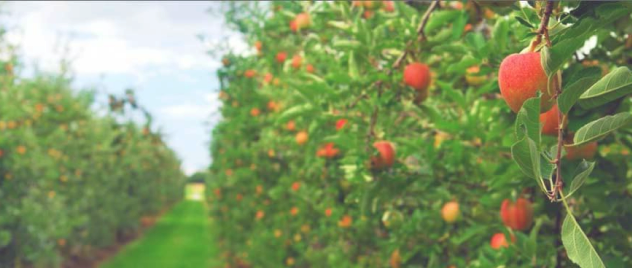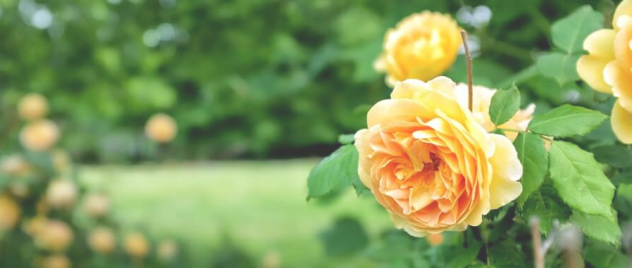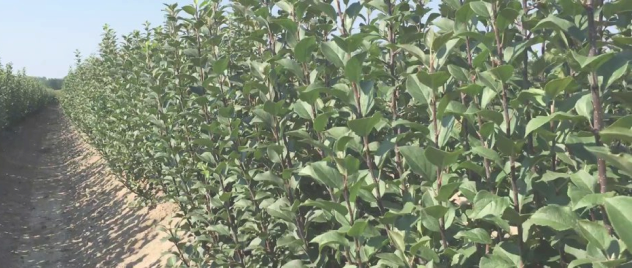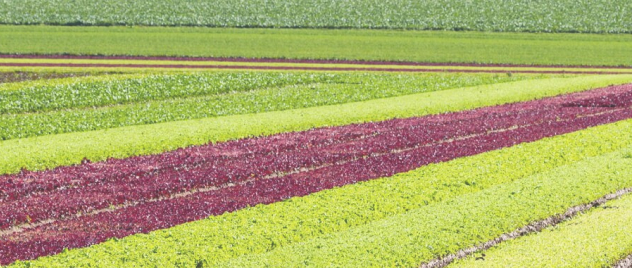SWEET CHERRIES
Sweet cherry (Prunus avium L.) is a deciduous woody plant and belongs to the Rosaceae family and Prunoideae subfamily. The fruit is a monocarpic pome, with a spherical appearance and dark red, pink, or yellow color. The fruits are meaty, sweet-tasting, 2-3 pieces stacked together on stalks. Sweet cherry is a very important agricultural plant and its fruits are in high demand both for fresh consumption and for processing. Sweet cherry has the most vitamin C compared to other pome fruit. The fruit is also rich in zinc, folic acid, calcium, antioxidants, and flavonoids which play an important role in a healthy diet. Cherry also contains cellulose, which tightly regulates digestion.
CHERRY
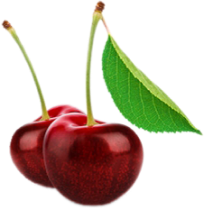
ROOTSTOCKS
PRUNUS AVIUM
This is a seedling rootstock, very vigorous thus not suitable for intensive orchards. Compatible with many varieties when it comes to sweet cherries. Produces large and highly prolific trees that are usually more vigorous than Mahaleb, especially when it comes to poorer soils. Suitable for wet and heavy soil types.
PRUNUS MAHALEB
A traditional seedling cherry rootstock. Perfect for traditional and modern orchards, though slow-growing. Induces early and abundant crops. Suitable for various soil conditions. The best cherry rootstock for drought conditions, not suitable for heavy wet soils. The most cold-hardy variety of all the commonly used cherry rootstocks.
TRAINING SYSTEMS
DWARF PYRAMID
One of the best training systems for cherries for maintaining a high-density orchard.
The height of the trunk should be 50 cm if handpicking is intended, or a bit higher if a mechanized harvest is planned. The base of this system are strong skeletal branches that give the crown a loose form and helps to illuminate the crown. Yielding branches are evenly spaced on skeletal branches and maintain a larger capacity of fruit-bearing, better quality, and yield per hectare. When planted, in Spring, the tree is cut down to 70-80 cm and the buds and branches are removed to 50 cm from the ground leaving 5 buds. The top one is left to form a leader and 4 to form skeletal branches. During the summer, usually in late July, all of the new side branches are shortened to about 15-20 cm, pruning to a downward pointing bud, the leader branch should be left freely. If the side shoots appear too close together, some are completely removed to leave a well-shaped tree. Trees formed in this way are easily netted from birds, which is very important with cherries.
OPEN VASE
After planting, in spring, the leader is cut 50-60 cm above the ground and all side-branches from the ground, but if there are at least two desirable branches, then retain those branches. If not, in the summer, when young branches are forming, 3 well-formed, and evenly spaced branches are left to form a crown and others removed. They should be at a 45° angle from the trunk or formed in that way. In the spring of the following year, new branches are cut to 45-50 cm length, all premature shoots that grow to the inside of the crown are removed. The aim is to reach a balanced growth of side branches, and if necessary, cutting, bending branches, and other measures are taken to reach the balance. This will form 2nd tier branches on the crown. The same measures and system is taken in the 3rd and 4th year.
See our full SELECTION of SWEET CHERRY TREES we have in our offer
BURLAT
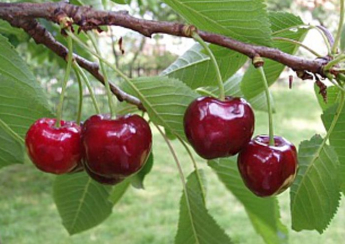
TREE:
The growing habit of Burlat is spreading and it has moderate vigour and a round canopy. When it starts yielding, the yields are regular and abundant. Blossoms mid-early.
POLLINATORS:
Stella, Van.
FRUIT APPEARANCE:
Heart-shaped fruit with burgundy dark red skin. The flesh is dark red, medium-hard, juicy, sweet in taste, and a pleasant aroma.
FRUIT SIZE: Large.
HARVEST:
Early, end of May.
COMMERCIAL USE:
One of the most important early varieties. Great quality, handles transport excellent. Used as a dessert fruit and in the processing industry.
HEDELFINGEN
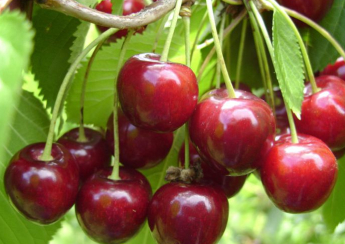
TREE:
It is a robust and vigorous variety with a semi-erect bearing. It blossoms early to mid in the season. Productive and tolerant variety. It starts yielding early in its life and develops best when the orchard has good sunshine exposure.
POLLINATORS:
Self-sterile. The best pollinators are Kordia, Stella, Sunburst, Bing.
FRUIT APPEARANCE:
Elongated and heart-shaped. Skin is glossy, rich dark red in color. The flesh is dark red, firm, crisp, juicy. Taste is sweet-sour, with a nice aroma.
FRUIT SIZE: Large.
HARVEST:
Late in the season. Mid-June.
COMMERCIAL USE:
Consumed fresh and also used in cooking and baking. It is valuable to the processing industry as it can be preserved, canned, and frozen.
SUNBURST
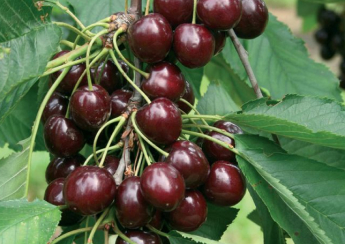
TREE:
Semi-erect bearing, medium vigorous development, bushy habit. Flowering is mid-late. This variety is very fertile and a regular high yielder with a rapid start in production. Works best if there is full sun exposure. Thinning should be applied adequately, every season.
POLLINATORS:
Self-fertile. Often used as a pollinator for other varieties.
FRUIT APPEARANCE:
Round in shape, purple-dark red to black skin, glossy, strong. The flesh is quite firm, sweet, great quality.
FRUIT SIZE: Very large fruit.
HARVEST:
A late variety. Middle to the second part of July.
COMMERCIAL USE:
Self-fertile and an excellent yielder, this large cherry is an important variety on the market. It handles very well and it is great for transport. Great as a table variety, but also widely used in the processing industry.
KORDIA
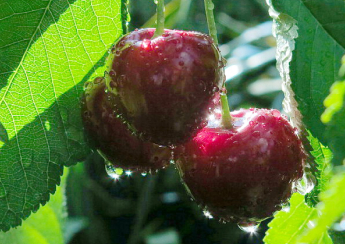
TREE:
It flowers mid to late season, around 10 days after Bing variety. Vigorous, branches well. It is best to plan for pollinators in the orchard as it is not entirely self-fertile. Also, it is best to plan such a position to leave a good amount of sunshine for the tree.
POLLINATORS:
Stella and Sunburst are suitable pollinators for this variety.
FRUIT APPEARANCE:
Oblong heart-shaped, deep red to black skin, with red, crunchy flesh. Sweet and juicy.
FRUIT SIZE: Larger than average size.
HARVEST:
Midseason (early to mid-July).
COMMERCIAL USE:
Due to its resilient firmness and great post-harvest holding capacity, it is well appreciated among industry producers.
STELLA

TREE:
Medium-vigorous, fast-growing, with a good branching habit. Mid-early blooming, early yielding, and regular and abundant crops. Easy to grow, often used as a pollinator.
POLLINATORS:
Self-fertile.
FRUIT APPEARANCE:
Characteristic heart shape. The skin is dark ruby red to purple, almost black in color, with dark red flesh color. The flesh is firm, crunchy, juicy, sweet-sour in taste, with a very pleasant aroma.
FRUIT SIZE: Gives large, heart-shaped cherries..
HARVEST:
Most commonly in (early to late) July.
COMMERCIAL USE:
Due to its sweetness and firmness it is appreciated as a dessert fruit, but can be also used widely in the fruit processing industry.
LYONS EARLY
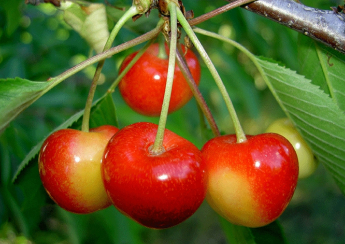
TREE:
The Lyons Early cherry tree is a medium-sized tree with an upright and spreading growth habit. It is vigorous and forms a spreading canopy with branches in a dropping manner. It blooms early to mid-early, usually in late March or early April. The tree is known for its early fruiting, allowing for an early harvest.
POLLINATORS:
Lyons Early cherries are self-fertile. However, planting compatible pollinators nearby, such as Bing, Stella, Lapins, or Van cherries, can potentially enhance fruit set and yield.
FRUIT APPEARANCE:
Lyons Early cherries are medium-sized fruits with a round to slightly heart-shaped form. The smooth and glossy skin showcases an enticing transition from bright red to a deep crimson hue as they ripen. The cherries' vibrant color and plump appearance make them visually appealing and irresistible. The flesh of Lyons Early cherries is firm and juicy, offering a delightful burst of sweetness with a subtle tang. Its texture is smooth and succulent, making them enjoyable to bite into.
FRUIT SIZE:
Lyons Early cherries are typically medium-sized, though they can vary depending on growing conditions.
HARVEST:
Lyons Early cherries are usually ready for harvest in the early summer, typically from late May to early June, depending on the specific growing region and climate. Yields early, regularly, and abundantly.
COMMERCIAL USE:
Lyons Early cherries are one of the most spread varieties, and are considered a high-quality cherry for their early fruiting and exceptional flavor. While they are delightful to eat fresh, they can also be used in processing. Their balanced sweetness and tangy undertones make them a versatile choice for desserts, jams, and preserves. Their early harvest window also makes them valuable for commercial purposes, as they can provide an early-season crop that appeals to consumers looking for fresh cherries.
VAN

TREE:
The Van cherry tree is a medium-sized tree with an upright and spreading growth habit. It forms a well-rounded canopy with moderate vigor. It blooms typically mid-early in mid to late April or early May, a very fertile variety, it yields are abundant.
POLLINATORS:
The Van cherry is a self-sterile variety, meaning it requires cross-pollination. Good pollinator options for Van cherries include varieties such as Bing, Stella, Rainier.
FRUIT APPEARANCE:
Van cherries are medium-sized fruits with a rounded heart-shaped form. The smooth skin has a glossy bright red color that intensifies as the cherries ripen. The fruit's appearance is visually appealing with its vibrant hue and plump shape.The flesh of the Van cherry is firm, juicy, and succulent. It boasts a rich red color, complementing its sweet and slightly tangy flavor. The cherries offer a delightful balance of sweetness and acidity, making them suitable for both fresh consumption and various culinary uses.
FRUIT SIZE:
Van cherries are typically medium to large in size, depending on growing conditions. They have a satisfying weight and substantial presence when fully mature.
HARVEST:
Van cherries are usually ready for harvest in the early to mid-summer, typically from mid June to early July, depending on the specific growing region and climate.
COMMERCIAL USE:
Van cherries are highly valued for their versatility in culinary applications, but are also popular as a dessert fruit. They are delicious when enjoyed fresh, offering a burst of flavor with each bite. Additionally, Van cherries are suitable for a wide range of culinary creations, including pies, tarts, jams, preserves, and desserts.
BING

TREE:
The Bing cherry tree is a medium to large-sized tree with a spreading growth habit. It forms a well-rounded canopy with moderate to high vigor. It bloomsmid-late, typically in late April or early May. Yields are very well.
POLLINATORS:
The Bing cherry requires cross-pollination, and good pollinator options for Bing cherries include varieties such as Van, Stella, Hedenfingen.
FRUIT APPEARANCE:
Bing cherries are large, heart-shaped fruits with a glossy and smooth dark red to almost black skin. Their deep red color is highly attractive and gives them a striking appearance. The cherries have a firm and juicy texture. The flesh of Bing cherries is tender, succulent, and juicy. It has a vibrant reddish color and offers a delectable balance between sweetness and slight acidity. The cherries have a rich and intense flavor that is often described as both sweet and tangy.
FRUIT SIZE:
Bing cherries are known for their large size, plump and substantial presence.
HARVEST:
Bing cherries are usually ready for harvest in the mid to late summer, typically from late June to early July, depending on the specific growing region and climate.
COMMERCIAL USE:
Bing cherries are an old variety but still one of the leading in cherry production. Used widely as a table and industrial variety. Highly regarded for their exceptional flavor and versatility. They are perfect for enjoying fresh, offering a burst of sweetness with every bite. Bing cherries are also excellent for use in desserts, jams, pies, and other culinary creations where their rich flavor and deep color shine through. Their size, appearance, and outstanding taste make them a popular choice.

